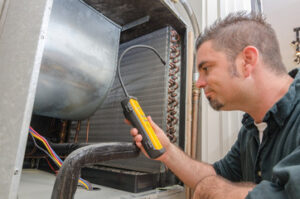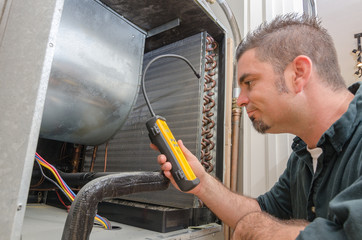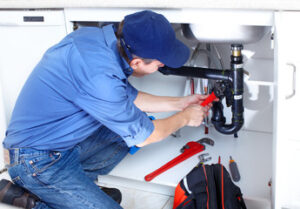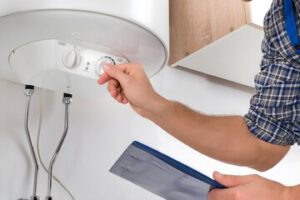Leak detection is a non-invasive method of finding leaks that can save you money in the long run. It allows plumbers to see the problem without tearing up floors or breaking down walls.

Many leaks are undetected and can cause extensive water damage. These leaks may be hidden behind walls, ceilings, or even underground. Visit Website to learn more.
Light detection and ranging (LiDAR) technology sends laser pulses that reflect off of objects, enabling precise measurements of distance that create 3D representations. This advanced technology finds wide application across numerous industries, including oil and gas, for mapping complex topography and monitoring changes caused by methane leaks.
LiDAR systems measure differences in the time it takes for a laser pulse to reach its destination from various points on or above the ground. This measurement of surface characteristics provides information that reveals features hidden below vegetation or obstructed by terrain, like buried pipes and conduits.
The resulting data is often a point cloud, a collection of individual data points arranged in three-dimensional space. The resolution of the point cloud determines how detailed the resulting map will be. A balance between resolution and accuracy must be struck, with the ideal varying depending on the specific requirements of each project.
A LiDAR system’s scanning mechanism is another determinant of its performance and ability to capture quality data. Mechanically operated systems use spinning mirrors or other components to direct laser beams, and they’re typically used to scan larger areas with higher resolutions. Their complexity and mechanical components, however, can introduce points of failure into the data.
LiDAR’s ability to penetrate dense forest canopies is useful in many ways for conservationists, but it also gives rise to a host of new opportunities for companies that depend on the world’s forests, like paper, syrup and furniture production. LiDAR allows forestry professionals to quickly and accurately map miles of forest, speeding up traditional surveying and saving valuable resources.
Other uses for LiDAR include monitoring methane emissions in natural gas pipelines. In these applications, drone-mounted LiDAR sensors identify potential methane leaks and can help optimize field crew deployment. By leveraging GPS coordinates, LiDAR can save crews the expense and safety risks of traveling to 60% to 90% of all sites on foot, while still ensuring accurate methane reduction tracking.
Additionally, the information provided by LiDAR can be analyzed to identify contaminants in air or water. This analysis is made possible by tunable lasers, which emit specific frequencies that can be detected by the sensor. The precise chemicals that can be identified by DIAL will vary, but the list is expected to grow as reliable tunable lasers become more widely available.
Acoustic Leak Detectors
In pressurised water lines, leaks create a distinctive hollow sound that can be heard by experts using specialised listening devices. These devices are commonly known as “listening sticks” or acoustic detectors, and are used by professional plumbers to locate the location of leaking pipes without digging or tearing open walls or floors.
Acoustic leak detection is an effective tool for avoiding costly repairs, water loss, and disruption to service. In addition, it is also an environmentally friendly alternative to traditional trial-and-error methods such as digging or cutting into a wall or pipe.
Depending on the system being monitored, acoustic leak detection technology can provide real-time monitoring, sending an immediate alert when a potential issue is detected. This allows appropriate actions to be taken immediately, including shutting down systems or isolating the affected area and arranging for repairs.
In addition to an immediate alarm, some acoustic leak detection technologies offer advanced features like frequency analysis and data logging capabilities. These can help technicians pinpoint the exact location of a leak with great accuracy and reduce the chance of false positives or negatives. For example, by utilising noise cancellation techniques or deploying sensors overnight, where ambient noise is less prominent, technicians can improve the likelihood of detecting leak sounds and determining their exact location.
Acoustic leak detectors can be deployed at the surface level, or dropped into manholes for inspection and location of leaking pipes underground. They can be used for any type of pipe material, and can be particularly effective on buried steel or cast iron transmission mains that may produce very faint leak noises.
The sound produced by a leaking pipe is a low, baritone tone with a very distinctive hollow, vibrating quality. The acoustic technology used to detect these leaks is extremely sensitive and works by recording the sound of a leak and using digital instrumentation to isolate and amplify it. This enables experts to pinpoint the precise location of the leak, saving time and money that would be lost through trial-and-error methods. In conjunction with leak correlation, acoustic detectors can provide valuable information on the condition of an entire pipeline system, enabling the utility to manage and schedule repairs accordingly.
Infrared Cameras
An infrared camera detects invisible light that exists outside the range of visible light. The camera converts these frequencies into a thermal image on its screen or viewfinder that displays differences in surface temperatures. These temperature variations can be harbingers of hidden water leaks, which can result in structural damage, mold development and other health hazards. Infrared cameras are ideal for detecting moisture and identifying sources of condensation and other potential problems.
IR camera systems work in the near-infrared (NIR) electromagnetic spectrum that lies between visible light and X-rays on the electromagnetic spectrum chart. They are not designed to see through walls or other solid objects, but rather to measure the infrared radiation reflected off those surfaces and structures. There are special sensors available that cover different portions of the NIR spectrum: short-wave infrared (SWIR) for the lowest frequencies, long-wave infrared (MWIR) for medium-range applications and the extended MWIR which covers a larger area than MWIR but doesn’t go all the way to the IR spectra of CO2 molecules that tend to attenuate light a lot more in that region.
The camera’s detector chip contains thousands of pixels arranged in a grid. Each pixel responds to the infrared energy focused on it and produces an electronic signal that is processed by the camera’s circuitry. That signal is then translated into a temperature map with each individual pixel showing its own apparent temperature value in a matrix of colors. The camera’s display then shows the resulting image with warmer areas appearing as brighter or lighter colors and cooler areas displayed as darker shades.
Important preparatory steps should be taken prior to using an infrared camera for leak detection. First, make sure the area is dry and clear of anything that might interfere with the camera’s ability to accurately measure heat. Then, read the camera’s user manual to get familiar with its features and capabilities. It’s also helpful to take digital photos of the problem area and include them with the thermal images to help identify the location of a leak. In addition, the IR PhotoNotes feature on Fluke’s IR camera system allows users to store voice or written notes with each photo for future reference.
Moisture Meters
Moisture meters provide an instant and non-invasive readout of a surface’s moisture level, making them ideal for inspecting new homes, identifying dry lumber, and pinpointing water leaks. These devices emit a low-frequency electrical signal, which the material absorbs. The instrument then measures the variation of wave characteristics created by the absorbed energy, which in turn reflects the material’s moisture content. Moisture meters can detect moisture in a variety of materials, including wood, plaster, and carpet.
Pin-type and pinless models are available for use in a wide range of building materials. Depending on the model you choose, the device may be capable of measuring moisture at varying depths. Many of these devices offer the option to attach a probe to allow you to insert the meter into a hole in the wall for more detailed testing.
A pin-type moisture meter has two to four sharp, high-precision stainless steel pins that penetrate the surface of the test material. The meter uses the pins to create an electronic current that causes the probes to change in response to the material’s moisture level. The meter’s sensor pad then evaluates the changes in the wave pattern reading to calculate the resulting moisture content of the tested material.
In contrast, pinless meters do not leave any indentations on the surface they are testing. These models utilize a sensor plate that transmits an electromagnetic signal, which is then evaluated by the meter. The resulting variation in the readings is compared to those of dry materials to determine a moisture level.
Both types of moisture meters are generally easy to operate, even in the dark. Most are calibrated to measure the moisture content of wood and include visual LED indicators that display a percentage of a dry, moderate, or saturated measurement. Some moisture meters can also be used for testing concrete and gypsum, but their sensitivity levels are often lower than for wood.
A moisture meter can help you identify the source of a leak by following the highest moisture readings in the area. In many cases, these readings will show the area of the leak and can help you determine if it is a problem with plumbing, roofing, or other structural components.



